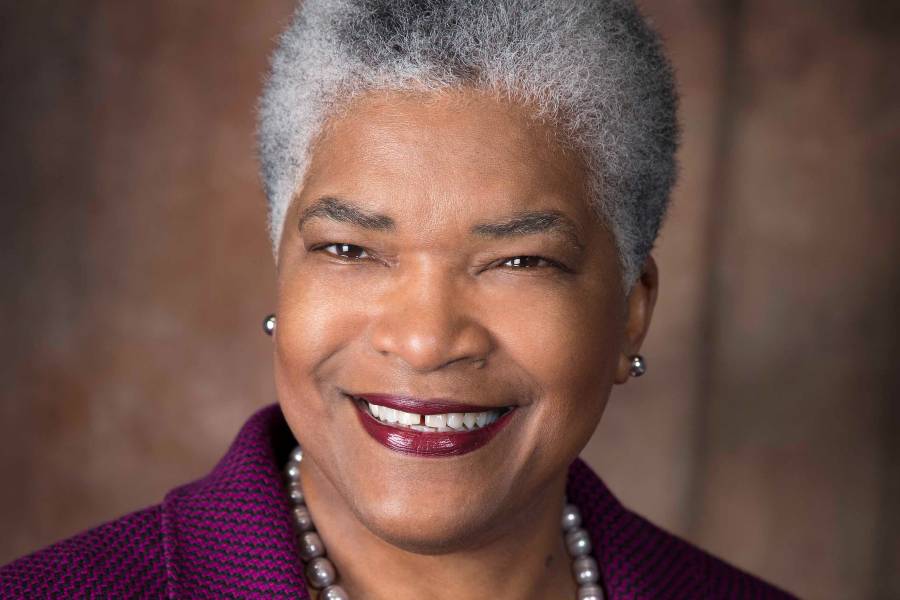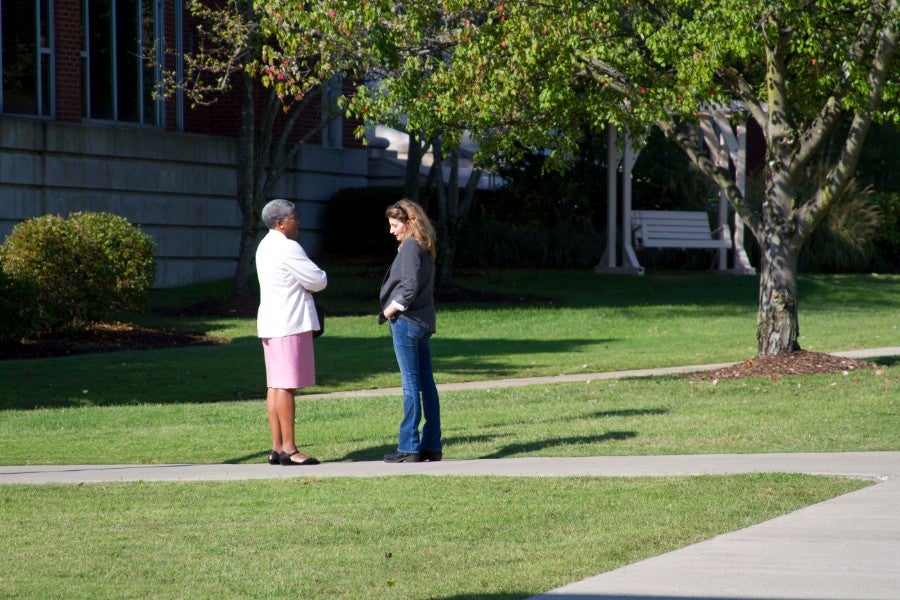Burgess has vision for supporting growing diverse campus
Norma Bond Burgess is hard at work making a difference through her work in the Office of Diversity, Inclusion and Special Initiatives.
Kim Chaudoin |

Norma Bond Burgess, associate provost for diversity, inclusion and special initiatives
Norma Bond Burgess likes to build things.
On Aug. 1, 2009 Burgess set foot on the Lipscomb campus with the charge to build the university’s College of Arts & Sciences, which was an outgrowth of a reorganized college structure that combined the Colleges of Arts & Humanities and a majority of the College of Natural & Applied Sciences that existed at that time.
As founding dean, Burgess built that into a thriving entity from which a College of Liberal Arts & Sciences and the George Shinn College of Entertainment & the Arts grew.
Over the past two years, Burgess has donned the proverbial hard hat and is hard at work creating a new structure once again. This time she is building the Office of Diversity, Inclusion and Special Initiatives as associate provost in the Lipscomb University provost’s office.
“I have had the opportunity to set a vision based on where we are today as a university and where we as an institution need to be in the next ten years in the significant areas of diversity and inclusion,” says Burgess.
Lipscomb University provost, W. Craig Bledsoe says Burgess is filling a critical need for the institution.
“Dr. Burgess and I have discussed the academic area’s need to increase diversity among our faculty and students, to develop programs and initiatives to create cultural awareness on our campus and to foster respect for diversity and inclusion in our campus community,” he says. “Dr. Burgess is providing great expertise and vision to the provost’s office in these areas which are vitally important to the wellbeing of any university environment or community. I am grateful for Dr. Burgess’s leadership and for the continued impact she is going to have through this new role.”
Changing demographics
When thinking strategically about where Lipscomb will be a decade down the road in regards to diversity on campus, Burgess looks to the changing U.S. demographics and the increasing diversity of the university’s hometown — Nashville, Tennessee.
Today, according to the US Census Bureau, the country’s population is comprised of 60.4 percent white (not Hispanic or Latino), 13.4 percent black, 18.3 percent Hispanic or Latino, 5.9 percent Asian and 2.7 percent two or more races. The bureau projects that by 2045, whites will comprise 49.7 percent of the population in contrast to 24.6 percent for Hispanic or Latinos, 13.1 percent for blacks, 7.9 percent for Asians, and 3.8 percent for multiracial populations.
According to the U.S. Census Bureau, Nashville’s population is currently comprised of 55.6 percent white (not Hispanic or Latino), 27.8 percent black, 10.4 percent Hispanic or Latino, 3.6 percent Asian and 2.5 percent two or more races. The foreign-born population in Nashville has nearly doubled over the last decade and makes up about 12 percent of the population, according to World Population Review. The city is home to large populations of Mexicans, Kurds, Vietnamese, Cambodians, Laotians, Arabs and Bantus. Nashville is home to the largest population of Kurdish people in the country, while many of around 60,000 Bhutanese refugees admitted to the country settled in the area.
As a faith-based institution, the Lipscomb environment should represent Christ-like behaviors when people are invited into it; it should reflect a place of learning and hospitality. — Norma Bond Burgess, associate provost for diversity, inclusion and special initiatives
“In the next decade the demographics of the country and our city are changing dramatically. In order to prepare for that and to develop a university environment that an increasingly diverse student population wants to be a part of, we must be intentional about being a community that has more engagement with and is a more supportive environment for people who are historically underrepresented,” Burgess says. “This includes not only our students, but faculty and staff as well. Our faculty will be more representative of the students that we serve.”
Just as the world around us becomes increasingly diverse, Lipscomb University’s student body will reflect that diversity making the campus community one that is a richly woven fabric with many cultural backgrounds and experiences. This past academic year the student body represented 46 states (including Washington, D.C., and Puerto Rico) and 52 nations and was comprised of 24 percent ethnic minority students.
In this role, Burgess reviews existing policies, creates new ones and develops recruiting and retention strategies. But she sees her greatest calling as helping build an environment that reflects the increasing diversity of the nation and a place that appreciates all of its members.
“As a faith-based institution, the Lipscomb environment should represent Christ-like behaviors when people are invited into it; it should reflect a place of learning and hospitality,” Burgess says.
“I compare it to visiting a congregation for the first time. You wonder if anyone is going to come up and say hello or welcome you. Similarly, when people come to a new campus, there must be objects in it that say, ‘oh, you can come here. You are welcome. We want you to be here. We will support you and will develop strategies to help you.’”
“As a community, we need those to be visible, because they’re not always as visible as we like to think,” she continues. “I want to help us as we move forward in how we greet each other, treat each other and offer support to each other in this environment.”

Norma Bond Burgess engages students, faculty and staff in her work with diversity and inclusion.
Education helps understanding
Burgess has several strategies for building this kind of environment on campus. One is through education. Among her goals are to develop a world history class that educates students on the history of various cultures, how they developed, the challenges and “why things are the way they are” with particular preconceived notions or misinformation. She has also coordinated a signature annual MLK event. For this year's event, she convened a panel of experts for a forum entitled "Keeping Our Community Healthy," to explore health disparities in today’s community.
“We just don’t talk about it that way,” she admits. “We talk about things as if they’ve always just been this way but we know that they have not. Our students, faculty and staff don’t always know that … and they will never know if we don’t educate them. We become narrow-minded when we know what we know but we don’t know enough.”
Providing learning opportunities for faculty and staff is also among Burgess’s plans through initiatives such as a series of workshops in partnership with human resources to help us become more culturally aware and to better serve students’ needs.
The power of dialogue is one of the best ways to create change, Burgess believes.
“Conversations about what a welcoming environment looks like to each of us in ways that we can be better Christians, better colleagues, better workers,” she says. “People bring different perspectives and ideas of what they hope to get from these conversations. Conversations that we’ve never had that need to be had are really helpful and can have a tremendous impact on a community. It helps us all hear each other and to understand why it’s important and why diversity matters.”
People do want to get involved and make a difference, Burgess believes.
“Since people have known that I’m in this role, I’ve had many say to me, ‘Let me know if you need some help,’” she says. “There are so many good people on our campus who are willing to do something … but they just aren’t sure what to do. And that’s ok. I’m here to help us all figure out how to build a more enriching environment for all.”
She hopes to make an impact on increasing the diversity of the faculty and staff, to encourage more students of color to explore academic options including study abroad opportunities. She is investing time talking to peers at other institutions, attending conferences to learn best practices, issues, opportunities, needs and more that impacts this field and will help shape what Burgess is building at Lipscomb. She also meets regularly with faculty, staff and students at Lipscomb throughout the next year.
Since people have known that I’m in this role, I’ve had many say to me, ‘Let me know if you need some help. There are so many good people on our campus who are willing to do something … but they just aren’t sure what to do. And that’s ok. I’m here to help us all figure out how to build a more enriching environment for all. — Norma Bond Burgess, associate provost for diversity, inclusion and special initiatives
Burgess collaborates with William Turner, special counsel to the president for diversity and inclusion at Lipscomb, and Prentice Ashford, dean of community life, as the university has increased its focus on providing resources to serve this diverse community and building respect for all who are a part of it. This month, they launched a Race/Ethnic Campus Climate Survey to assess the racial and ethnic climate of the university and gather information and insights that will be invaluable in future planning.
Burgess has also worked with the Office of the Provost to plan and coordinate new research initiatives centered around the family. In her post-doctoral research, she coined the term “sociohistoricism.” "As a sociologist, I use an historical lens to discuss what I want to talk about. It’s a lens that I still use today to examine contemporary issues. I have found that an interdisciplinary approach works best," she says.
A Career Devoted to Education
In her nine years as dean, Burgess led the successful merger of the College of Natural & Applied Sciences and the College of Arts & Humanities to form the College of Liberal Arts & Sciences as well as the launch of a number of new programs and initiatives including the Student Scholars Symposium, the Ward Scholars program with Jeff Fincher, the graduate program in biomolecular science, and accredited programs in marriage and family therapy. Additionally, under her leadership the biology program was ranked No. 1 in the nation in the “Top 10 Christian College Biological Degree Programs 2017” Christian Universities Online ranking.
Before coming to Lipscomb, Burgess was founding dean of the College for Graduate Studies at Chatham University in Pittsburgh. As she built that college, Burgess was responsible for every aspect of graduate education, including new program development, faculty evaluation, budgetary management, academic management, and faculty and support services.
From 1993-2007 at Syracuse University, Burgess earned the rank of full professor while chairing the Department of Child and Family Studies; she also served as academic co-chair of the Bachelor of Professional Studies program. Internationally, she served as a visiting professor for the University of the Aegean in Rhodes, Greece, and as a member of the summer faculty at Cornell University. Dr. Burgess is a widely published scholar with a focus on work and family and leadership development.
Burgess has served as chair of the women’s caucus of the American Association of Higher Education and is currently president-elect of the National Council on Family Relations, the premier professional association for understanding families through interdisciplinary research, theory, and practice. She is co-author of African American Women: An Ecological Perspective and numerous articles and other writings on work and family life, leadership, faculty development and workplace diversity.
Burgess holds a doctorate in sociology and a master’s degree in public affairs from North Carolina State University as well as a Bachelor of Arts degree in political science from the University of Tennessee-Knoxville. She is a native of Stanton, Tennessee.
Want to know more? Contact Burgess at norma.burgess [at] lipscomb.edu.
— Photos by Kristi Jones